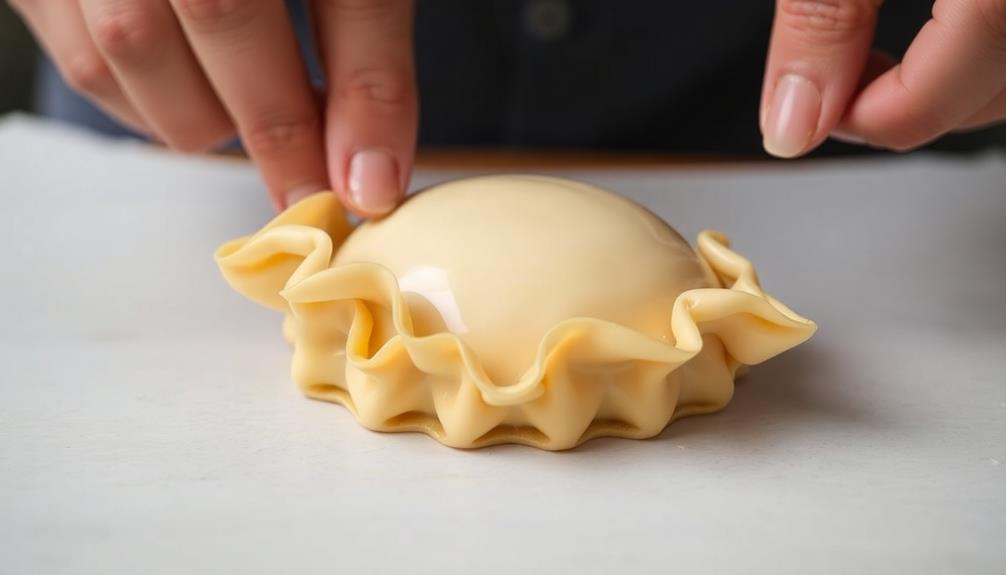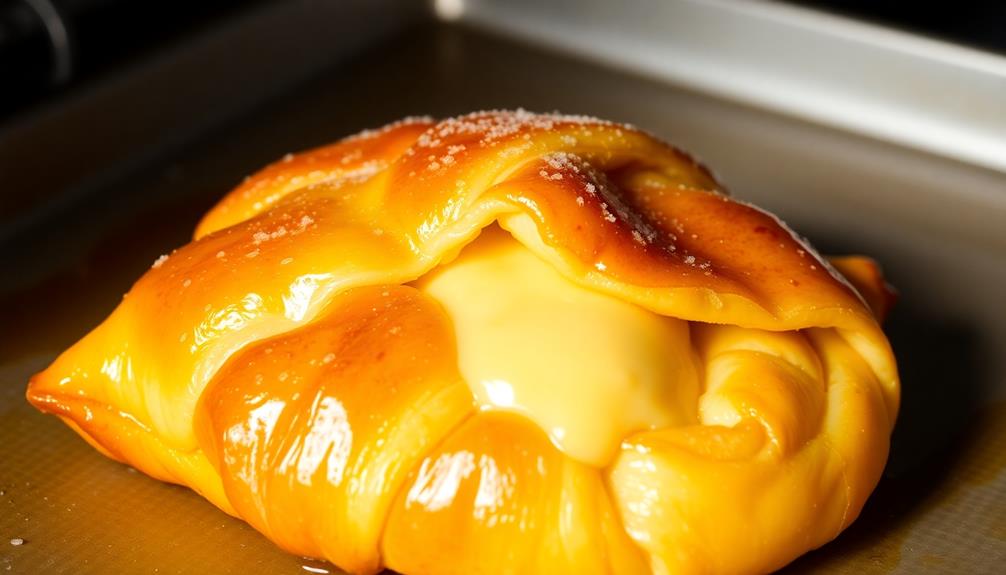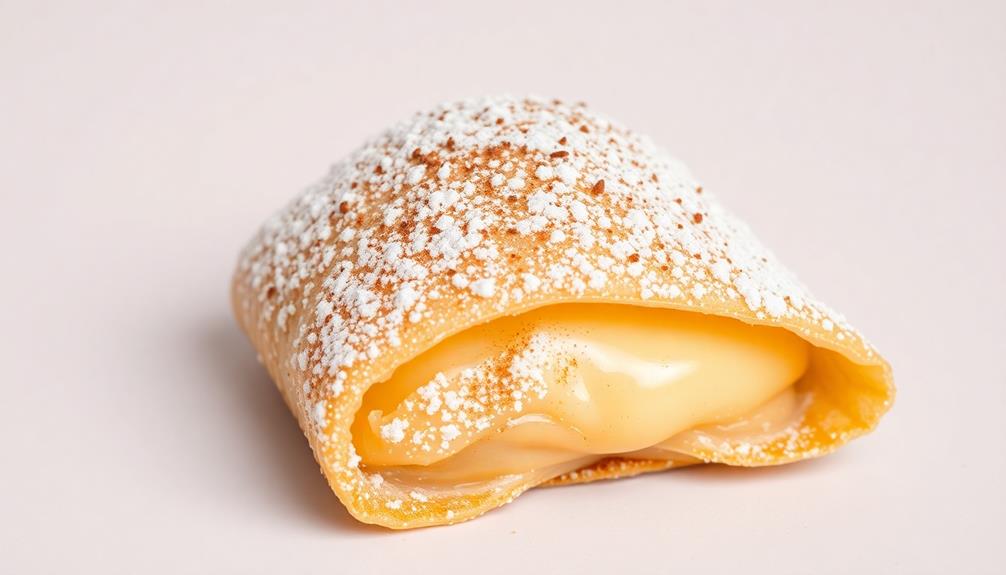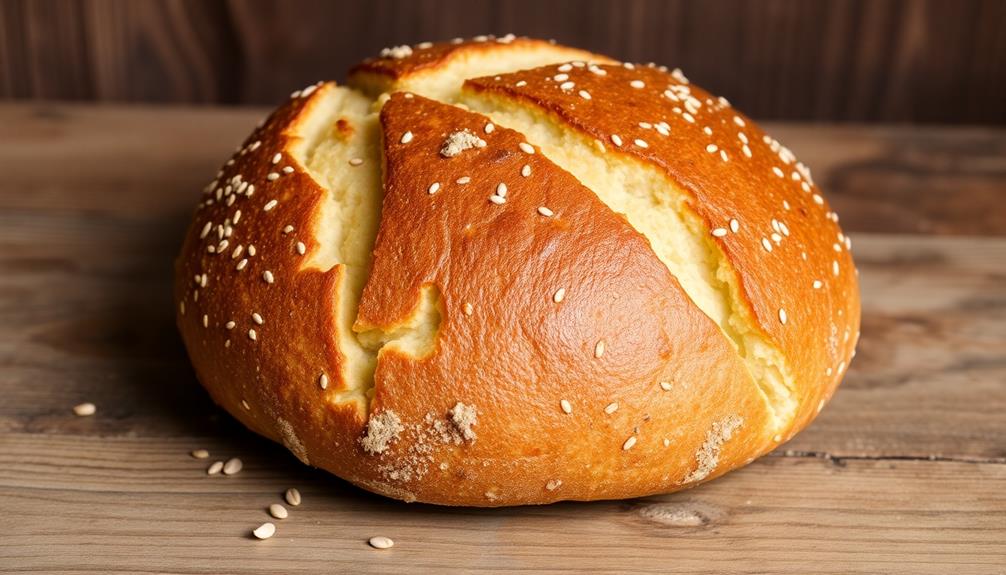Bougatsa is a mouthwatering Greek pastry that comes in both sweet and savory varieties. It features flaky phyllo dough cradling a creamy, vanilla-infused custard or a rich cheese filling. This beloved treat is a delight to bake, with the aromatic scents wafting through the kitchen as it bakes to a golden brown. Whether you prefer the classic sweet version or the indulgent savory option, bougatsa is a true taste of Greece that will transport you to the Mediterranean. And if you're curious to learn more about this captivating pastry, just keep reading. If you’re feeling adventurous, you can even experiment with adding different flavors or fillings to create your own unique twist on this classic dessert. And if you’re a fan of Greek pastries, you’ll definitely want to try your hand at making a traditional baklava recipe, with layers of buttery phyllo dough and sweet, honey-soaked nuts. The rich, indulgent flavors are sure to impress your family and friends. So why not explore the delicious world of Greek pastries and bring a taste of the Mediterranean into your own kitchen?
Key Takeaways
- Bougatsa is a traditional Greek pastry with roots tracing back to the Byzantine era, available in both sweet and savory variations.
- Sweet bougatsa is typically filled with a creamy semolina custard, while savory versions feature a decadent cheese mixture.
- The pastry is known for its flaky, golden-brown exterior and soft, creamy interior, often served warm.
- Bougatsa is a symbol of Greek hospitality and cultural heritage, commonly enjoyed for breakfast or as an afternoon snack.
- Preparing bougatsa requires skill and attention to detail, from rolling the thin phyllo dough to baking the pastries to perfection.
History
Originating from Greece, bougatsa is a delicate and creamy pastry that has captivated the hearts and palates of people across the Mediterranean region. This beloved treat has a rich history, tracing its roots back to the Byzantine era. The name "bougatsa" is derived from the Byzantine Greek word "βουκέλλας" (boukellatos), which referred to a similar type of custard-filled pastry.
Over the centuries, bougatsa has evolved, reflecting the diverse culinary traditions of the regions where it's been enjoyed. In Greece, it's often served for breakfast, with a dusting of powdered sugar and cinnamon, creating a heavenly contrast of flavors and textures.
Elsewhere, savory versions featuring cheese or meat fillings have also gained popularity, showcasing the versatility of this beloved pastry. Whether sweet or savory, bougatsa remains a cherished part of the Mediterranean culinary heritage, a delightful treat that continues to delight and inspire food enthusiasts around the world.
Recipe
Bougatsa is a delectable Greek pastry that combines flaky phyllo dough with a rich, creamy custard filling. This traditional treat is a beloved staple across Greece, often enjoyed as a breakfast or afternoon snack. Alongside a steaming cup of coffee, bougatsa is the perfect way to start the day. Not only is it popular for breakfast, but it can also be found at local bakeries and markets throughout the day, satisfying cravings for something sweet and indulgent. Additionally, bougatsa pairs beautifully with traditional Greek loukaniko sausage for a savory and satisfying meal.
The secret to making an authentic bougatsa lies in the perfect balance of the buttery phyllo layers and the silky smooth custard. With a sprinkle of powdered sugar and a touch of cinnamon, each bite delivers a harmonious blend of flavors and textures that will transport you to the streets of Greece.
Ingredients:
- 1 lb phyllo dough, thawed
- 1 cup whole milk
- 1/2 cup granulated sugar
- 2 eggs
- 1/4 cup cornstarch
- 1 tsp vanilla extract
- 1/2 cup unsalted butter, melted
- Powdered sugar for dusting
- Ground cinnamon for dusting
Instructions:
Prepare the custard filling by whisking together the milk, sugar, eggs, and cornstarch in a saucepan. Cook over medium heat, stirring constantly, until the mixture thickens. Remove from heat, stir in the vanilla, and let cool completely.
Preheat the oven to 350°F (175°C). Unroll the phyllo dough and cut it into 4-inch squares. Brush a baking sheet with some of the melted butter. Layer 4-5 squares of phyllo, brushing each layer with butter. Spoon a heaping tablespoon of the cooled custard onto the center of the phyllo stack. Fold the corners of the phyllo over the filling, creating a neat package. Repeat with the remaining phyllo and custard.
Bake the bougatsa pastries for 20-25 minutes, or until the phyllo is golden brown and crispy. Remove from the oven and dust with powdered sugar and cinnamon immediately. Serve warm and enjoy the delightful contrast of the flaky pastry and the creamy custard.
Tips:
- Make sure the custard is completely cooled before assembling the bougatsa to prevent the phyllo from becoming soggy.
- Brush the phyllo layers generously with melted butter to ensure a crisp, flaky texture.
- Serve the bougatsa warm, as the contrast between the hot pastry and the cool custard is part of the appeal.
Cooking Steps
First, you'll need to make the dough by combining flour, milk, and eggs.
Once the dough is ready, roll it out into thin, delicate sheets.
Then, add your delicious filling and fold the dough over to create those classic bougatsa pastries.
Pop them in the oven, and get ready for a golden-brown masterpiece!
Step 1. Make Dough With Flour, Milk, and Eggs

To begin the dough-making process, you'll need a mixture of flour, milk, and eggs.
In a large bowl, combine 2 cups of all-purpose flour, 1 cup of lukewarm milk, and 2 lightly beaten eggs. Use a wooden spoon to stir the ingredients together until they form a smooth, elastic dough.
Don't be afraid to get your hands dirty! Knead the dough for about 5 minutes, working it until it's soft and pliable. If it feels a bit sticky, add a sprinkle of flour.
Once the dough is ready, shape it into a ball and place it in a lightly oiled bowl. Cover with a damp towel and let it rest for 30 minutes. This resting period allows the gluten to relax, making the dough easier to work with later.
After the dough has rested, you're ready to roll it out and begin assembling your delicious bougatsa pastry. Get ready to create something truly special!
Step 2. Roll Out Dough Into Thin Sheets

After the dough has had its chance to rest, it's time to roll it out into thin, workable sheets.
Lightly dust your clean work surface with flour to prevent the dough from sticking.
Divide the dough into manageable portions, then use a rolling pin to gently roll each piece into a paper-thin sheet.
Apply just enough pressure to stretch the dough, but not so much that it tears.
Work slowly and methodically, turning the dough a quarter-turn after each roll to ensure an even thickness.
The sheets should be so thin that you can almost see through them.
Once you've rolled out all the dough, cover the delicate sheets with a clean, damp towel to keep them from drying out while you prepare the rest of the ingredients.
With the dough ready, you can now move on to assembling the classic Greek pastry known as bougatsa.
Step 3. Add Filling

With the paper-thin dough sheets ready, you can now focus on adding the classic bougatsa filling.
The traditional bougatsa filling is a rich, creamy custard made with milk, eggs, sugar, and vanilla.
Begin by heating the milk in a saucepan over medium heat, stirring occasionally, until it just begins to simmer.
In a separate bowl, whisk together the eggs, sugar, and vanilla until well combined.
Slowly pour the egg mixture into the hot milk, whisking constantly, to create a smooth, velvety custard.
Continue cooking, stirring frequently, until the mixture thickens to a pudding-like consistency, about 5-7 minutes.
Remove from heat and allow the custard to cool slightly.
Once cooled, spoon the custard filling onto the center of each dough sheet, spreading it evenly while leaving a small border around the edges.
Fold the dough over the filling, creating a neat, rectangular packet, then set aside while you prepare the next step.
Step 4. Fold Dough Over Filling

Once the custard filling has been spooned onto the center of each dough sheet, it's time to fold the dough over the filling.
Gently take the two opposite corners of the dough and bring them together, creating a neat, tidy package. Fold one side of the dough over the filling, then the other side, ensuring the filling is completely enclosed. Press the edges firmly to seal in the delicious goodness.
Next, use your fingertips to crimp and pinch the sealed edges, creating a decorative border that will hold everything in place. Be careful not to tear the delicate dough as you work. The goal is a perfectly folded pastry that's ready for baking.
Once the bougatsa is folded, transfer it to a parchment-lined baking sheet.
Repeat this process with the remaining dough sheets and filling, working quickly to keep everything fresh and warm. With the dough neatly folded, your bougatsa is now ready for the oven, where it will bake to golden perfection.
Step 5. Bake Until Golden Brown

Preheat your oven to 375°F (190°C). Gently transfer the prepared bougatsa into a baking tray, being careful not to tear the delicate phyllo dough. Arrange the pastries evenly, allowing a bit of space between them.
Now, pop the tray into the preheated oven and let the magic happen. As the pastries bake, your kitchen will fill with the most tantalizing aroma – a heavenly blend of warm custard, buttery pastry, and just a hint of fragrant spices.
Keep a close eye on them, as the phyllo can brown quickly.
After 20-25 minutes, the bougatsa should emerge golden-brown and irresistible. The top layers will be crisp and flaky, while the interior remains soft and creamy.
Let the pastries rest for a minute or two before serving warm. Whether you choose a sweet or savory filling, baking the bougatsa to perfection is the final step in creating this beloved Greek delight.
Final Thoughts
Bougatsa, a captivating Greek pastry, leaves a lasting impression. Whether you indulge in the sweet or savory version, this flaky delight is sure to transport you to the bustling streets of Greece. The crisp, golden-brown exterior gives way to a rich, creamy interior that simply melts in your mouth.
Crafting this pastry requires skill and patience, but the end result is well worth the effort. As you savor each bite, allow the flavors to dance on your tongue. The fragrant vanilla and the subtle sweetness of the semolina custard create a harmonious balance.
Or, if you prefer, the savory variant with its decadent cheese filling is equally satisfying. Whichever you choose, Bougatsa is a testament to the culinary artistry of Greece.
Embrace the joy of this traditional treat and let it transport you to the Mediterranean. Bougatsa, a pastry that truly embodies the essence of Greek culture and cuisine.
Frequently Asked Questions
Is Bougatsa Gluten-Free?
No, bougatsa is typically not gluten-free. It's made with phyllo dough, which contains wheat flour, a source of gluten. If you're looking for a gluten-free pastry, you'll need to find a recipe that uses alternative flours instead of traditional wheat-based dough.
Can Bougatsa Be Made in Advance?
You can definitely make bougatsa in advance. The pastry can be prepared and filled a day or two ahead, then simply bake it off when you're ready to serve. This makes it a convenient and easy-to-prepare treat.
How Long Does Bougatsa Keep?
You can keep bougatsa for a few days in the fridge, but it won't last more than 3-4 days. For best quality, it's better to enjoy it fresh, as the layers and texture won't hold up after a while.
Can Bougatsa Be Frozen?
Yes, you can freeze bougatsa. The pastry will keep in the freezer for up to 2 months. When you're ready to enjoy it, simply thaw it at room temperature before serving. Just be sure to handle it gently to preserve its delicate texture.
What Are Some Common Fillings for Bougatsa?
Common fillings for this delectable pastry include custard, semolina cream, and chocolate. You can also find savory versions filled with cheese, spinach, or minced meat. The possibilities are endless, so get creative with your favorite flavors!










